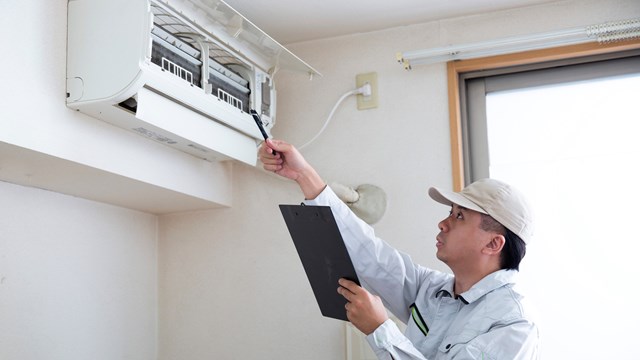
In this period of rising energy costs—not to mention the environmental threat of carbon emissions—community associations have a golden opportunity to realize substantial energy savings for their residents.
Since the association is typically responsible for roofing, siding, insulation and, frequently, HVAC, “buttoning up” a condominium can save money for everyone—and lower its “carbon footprint” in the process.
Even though buttoning up can translate into real savings, it’s a tough sell for many boards. Increasing energy efficiency offers a long-term return-on-investment that many board members will probably never see during their term. Plus, many association boards are strapped with tight budgets or limited reserve funds.
But experts report that condo boards can still work within a limited budget to lower costs of fuel, electricity and water. The incentive is there, so where to begin? Experts agree that any pursuit of energy savings should start with an energy audit.
Engineer Ralph Noblin, P.E., of Noblin & Associates of Bridgewater, Massachusetts, says the process can be narrowed down to simply, “looking at the building envelope” and taking a good look at individual components. “One of your bigger ‘bang for the buck’ items is windows,” he notes, such as installing Low-E glass (which has a surface that will repel the sun’s heat in the summer), and windows that are designed so that the space between the double-glazed panes does extra insulating duty, by creating a vacuum in the space or through the injection of super-efficient argon gas.
Also, it may be time for a new energy-efficient roof. Even under an older roof, he notes, “you can increase insulation to R-30 or R-40” with a quick fix of fiberglass batting or other insulating material.
Noblin pointed out that with new construction, architects and builders have the opportunity to “take advantage of the orientation of the building and placement of windows…” to account for solar effect or prevailing wind. (Insulation is rated by its R-value, which measures its thermal resistance or how well it holds back heat. The higher the R-value, the better.)
“In the 1980s, the state [Massachusetts] had money to pay for audits and help pay for part of the fix,” but a lot of government-sponsored programs have dried up, he says. A search of utility companies may turn up some help with free energy audits, however, he adds. For example, NSTAR offers an online audit that compares your home or building with a model of similar size and offers advice on what to look for and how to lower energy costs.
Call Your Supplier
Along with NSTAR, major energy suppliers such as Unitil or National Grid will also provide a free energy audit, conducted through the services of an engineering consultant. One such firm is Conservation Services Group of Westboro, Massachusetts. Bill Footer, program manager at CSG, explains that an audit is initiated “when a manager or board member contacts [the utility] call center with a request for a multi-family energy audit. A representative considers the property and approves the audit. Then we go out and assess the common area buildings along with a sample of individual units.”
“We look at all the lighting fixtures and bulbs. If it’s electric heat, especially, we look at insulation upgrades, installing programmable thermostats, upgrades to Energy Star rating for appliances such as refrigerators or the air seal in the ceiling,” says Footer.
"With five or more units, a community is eligible for multi-family programs. There are prescriptive solutions which the [utilities] offer, and we see if the customer qualifies for them,” Footer notes, adding, “We can give residents fluorescent, screw-in light bulbs, and the fixtures they fit into—for free.”
In wrapping up a typical audit for a customer, he states, “We issue a proposal… for any work that should be done.” This could mean anything from caulking air leaks around windows to replacing HVAC filters to adding insulation. “Then,” he continues, “we hire the contractors and do a sample installation. If the customer approves, then we order all the materials. We maintain quality controls as the work is going on. Once completed and approved, the customer gets billed for any possible co-pay.”
“We also have new construction programs for developers… We’d hope that builders have taken advantage of them,” Footer says. He points out, “Just because a development is new doesn’t mean it’s energy efficient… A builder might just cut corners to maximize profits over efficiency.
“That’s why it’s hard to use age as a factor when looking for a building’s energy use,” he adds. “Sometimes with older construction the owners have kept up,” with energy-saving upgrades and remodeling, so a building’s age reveals very little about its energy efficiency.
Air Blower Tests
At Burns & Associates Engineering in Portsmouth, New Hampshire, principal Bob Burns agrees that utility companies are a good source for some free advice on lowing energy costs, and quick, low cost solutions. He suggests going even further and rooting out air leaks with a “blower door” test. “This is where you depressurize the interior air,” he says, and measure the rate of air exchange to measure tightness of the building shell. “The rate of pressure change can be a very significant number.”
The test starts by closing all doors and windows, to simulate a heating season situation. A “blower door” then takes the place of the regular door. It seals the doorway and may incorporate gauges to indicate air pressure and rates of pressure change. It has a big fan which acts as an exhaust, venting the indoor air to the outside. This makes the interior air pressure drop in relation to the outdoor air pressure. A technician can then feel for air leaks around window frames, light fixtures and electrical outlets on walls and ceilings and at door jambs. In addition, a device that creates smoke can be used to make air leakage paths visible.
Burns points out that “if the rate of air exchange is minimal, there’s no need to research further.” Some minimal level of air exchange is recommended. An airtight interior is not the goal—that would compromise air quality and be potentially unhealthy.
Another “likely suspect” that wastes energy, Burns says, “is an old boiler [in the heating system] which may be running at 65 percent of efficiency… while a new boiler would get 95 percent. You can do an efficiency test on the boiler or the furnace.”
“There’s a lot going on with new construction, especially,” Burns reports, “Good work that’s going to show up in five or six years… but existing structures need attention too.”
For example, he adds, “We’re working with solar panels for water heating. This can be a significant addition for condos, since it’s a simple thing to do. The association can put the panels on the roofs. There’s a quicker return-on-investment in a community, where many units are serviced, than in a single-family home.” This incentive will start looking attractive to unit owners, he adds. “We’re working right now with a [condo] board to get the facts together on their energy consumption… We will present numbers on their use of domestic hot water.”
For condo associations, Burns notes that “I am also a reserve fund specialist. We see the whole energy policy [in communities] as tied into reserve funds.” If an association is serious about cutting energy costs, he contends, “the bottom line is the willingness of the board of directors to do something.” The building shells are the responsibility of the association, he states, “but the unit owners are getting the bill for the BTUs. They should be asking their directors, ‘Please tighten up the building shell.’”
His firm, he says, “is doing some education: asking these managers, boards and homeowners to get together. These condo boards are in a unique position to do some real energy management” since they have control over an entire community of building shells. For example, he asks, “Why couldn’t a condo board hire an HVAC firm to service the entire community? The incentive would be [an opportunity to] lower utility costs.”
Look at the Basics
Michael Andelman, a principal in Andelman & Lelek Engineering of Norwood, Massachusetts, reports that his firm works with mechanical systems and controls to analyze energy use and determine how to increase efficiency. “We use building energy models to predict energy use… we deal with the overall aspects of energy [management].”
A few years back, he admits, “Engineers didn’t pay much attention” to newer, energy efficient designs in boilers and condensers, but now everyone is paying attention. “There are definite upgrades available.”
That doesn’t mean that building managers are running out to buy new HVAC systems. “People are switching…if their equipment is really old.” It’s such a huge investment, he adds, “It’s not worth it otherwise—yet.”
Andelman notes that along with efficient mechanicals, architects and builders should always consider window materials and construction. “We presented the results of a glazing upgrade [to a client] and it was dramatic” in the energy savings. The two most important aspects of an energy audit or upgrade, he contends, are the efficiency of [HVAC] equipment and glazing.
And those two aspects would be useless without good insulation. One strategy for sealing and insulating the building envelope is to inject polyurethane foam insulation, which both seals and insulates. For that reason, Benjamin Marshall, a principal in Green Star Foam of Waltham, Massachusetts, says that “foam is the only complete solution for creating a more perfect building envelope. It’s both an insulation and a coating.” He reports that communities “can get big rebates… when they use [foam insulation] in their common areas” but it may depend on the definitions in their condo docs—and whether these buildings are considered residential or commercial.
Marie N. Auger is a freelance writer for New England Condominium magazine.






Leave a Comment